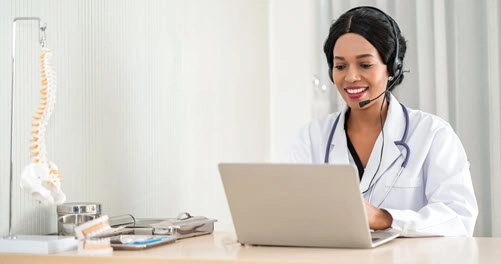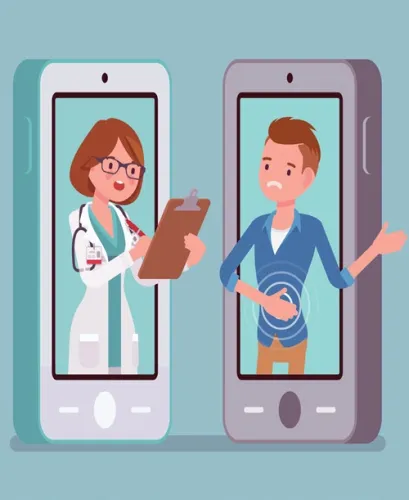Medicare Compliance & Reimbursement
Get the Scoop on 10 Telehealth Coding Facts From the Experts
Part B MAC reps offer provider tips with surprising and helpful insight. If you’re confused about the correct office code to use for COVID-19 test specimen collection or how to report prolonged services for a telephone-based encounter, you’re not alone. Fortunately, we’ve got answers, courtesy of Part B MAC reps who recently answered burning questions from the medical community. The Q&A session took place during Medicare Part B payer NGS Medicare’s Jan. 14 webinar, “COVID-19 Telehealth Services.” NGS’ Lori Langevin reminded providers that the public health emergency (PHE) has been extended through April 20. That means your telehealth billing skills must remain cutting edge — especially with changes possible under the new Biden administration. Don’t Forget These Telehealth Basics “On or after March 1, 2020 and for the duration of the PHE, you need to append modifier 95 [Synchronous telemedicine service rendered via a real-time interactive audio and video telecommunications system] to services performed via telehealth,” Langevin reminded attendees. “Modifier 95 indicates to the payer that the service was telehealth, and your payment will not be reduced. The place of service [POS] during the PHE is going to be equal to what it would have been if the visit had happened face-to-face,” she said. Additionally, when documenting telehealth services, remember to document the same way you would for any face-to-face patient encounter; “but, also indicate that the visit took place via telehealth and the mode of communication, along with the patient’s location, the provider’s location, the names of all persons participating in the telemedicine service, and their role in the encounter. For time-based services, you can document the stop/start time or the total time,” Langevin added. During the Q&A session, NGS’ Nathan L. Kennedy, Jr., CPC, CHC, CPPM, CPC-I, CPB, CPMA, provided answers to some of the most pressing questions Medicare practices had about telehealth and the PHE. Check out 10 of them below. 1. Can the GE Modifier Allow Residents to Report Phone Codes? One participant asked whether residents can report 99441-99443 (Telephone evaluation and management service by a physician or other qualified health care professional who may report evaluation and management services provided to an established patient, parent, or guardian not originating from a related E/M service provided within the previous 7 days nor leading to an E/M service or procedure within the next 24 hours or soonest available appointment…) if they use modifier GE (This service has been performed by a resident without the presence of a teaching physician under the primary care exception). “These are telephone E/M services performed by physicians who normally bill Medicare, so this is not typically going to fall into a teaching physician-type service,” Kennedy said. “In a teaching physician setting, the teaching physician is overseeing the resident and must be there for the key portions of the service and must be available by audio and video technology; so, so by the definition of the codes for telephone services, that technically does not seem to fit.” Caveat: If the resident is working under the primary care exception, they may be able to use those codes during the PHE — but the resident must meet strict guidelines to support billing these codes using the exception. 2. Can You Differentiate 99441 Series From 98966 Range? Another participant wondered whether nurse practitioners (NPs) and licensed clinical social workers (LCSWs) can report 98966-98968 (Telephone assessment and management service provided by a qualified nonphysician health care professional to an established patient, parent, or guardian not originating from a related assessment and management service provided within the previous 7 days nor leading to an assessment and management service or procedure within the next 24 hours or soonest available appointment...) or if they should instead bill a code from the 99441-99443 range. “A nurse practitioner would be able to use those codes [98966- 98968] or the 99441-99443,” Kennedy said. “The intent during the PHE is that nurse practitioners will use 99441-99443. Those codes have been established for those practitioners that can bill E/M services outside the PHE, but the way the PHE is set up they could bill for either set.” However, the LCSW would typically only report 98966-98968, since these providers can’t report 99441-99443, he indicated. “If an LCSW is checking in with the patient and providing an assessment of the patient and how they’re doing in a PHE … it’s really a brief sort of visit to find out how they’re doing and see if anything can be addressed over the phone,” he added. 3. Will Practices Eventually Return to Pre-PHE Rules? Prior to the PHE, telehealth was only allowed via the distant site, one webinar participant noted. They asked whether that will once again be the case once the PHE is lifted. “Yes, that will be the case,” Kennedy said. “The PHE has allowed CMS to bypass the Social Security Act, which is federal law, to allow telehealth services to be performed outside the scope in which they’re defined in that law.” However, once the PHE expires, “telehealth services will only be allowed for patients at a distant site, they will only apply to patients who are in rural, underserved areas, and all the legislation will go back into place,” Kennedy noted. Some specialty societies have approached members of Congress to try and get that law changed to make the telehealth rules permanent following the PHE, but as of press time, the rules are expected to revert back to the pre-pandemic regulations on April 21, 2021, he said. 4. Should You Resubmit Claims That Are Missing Modifier 95? Although you should be appending modifier 95 to your telehealth services during the PHE, some practices are collecting accurate reimbursement even if they forget to append it. One webinar participant asked whether they should create a reopening and resubmit such claims with the modifier appended. “You don’t have to,” Kennedy said. “Modifier 95 was listed as a requirement from CMS to indicate it was a telehealth service. If you don’t have it on the claim, you can go back and correct it. It’s not a requirement that you do, but make sure your records do note that telehealth was involved.” 5. Should You Report 99211 for Specimen Collections? One participant asked whether freestanding clinics that test patients for COVID-19 should bill 99211 (Office or other outpatient visit for the evaluation and management of an established patient, that may not require the presence of a physician or other qualified health care professional. Usually, the presenting problem(s) are minimal). “If it’s a freestanding clinic that bills services to Part B and the only service performed is a specimen collection, you can bill 99211 for that specimen collection,” Kennedy said. “If any other service is performed, that specimen collection will be bundled into that other service.” 6. Can You Determine the POS for an Emergency Department Service? One participant asked about the most accurate POS for emergency department (ED) services performed via telehealth. “The POS should be 23 [Emergency room – hospital] for the ED, because that’s where the service was rendered,” Kennedy said. “It’s the same as any face-to-face patient encounter.” 7. How Should You Document Time in 2021? Although most clinicians know how to document time; this year under the new E/M guidelines, some providers are confused about how to do so when billing telehealth visits based on time. “For 2021, there’s no real difference in documenting time, the documentation guidelines still apply,” Kennedy said. “The documentation needs to clearly indicate the time spent and the medical activities that were taking place that were pertinent to the patient’s care.” Important: One key factor that the AMA has emphasized is that the time tallied to select a level of service must represent medical-based services, Kennedy added. “If they’re talking about a baseball team, for instance, don’t count that toward the E/M service. Document the time that was spent and it needs to be clearly identifiable to an auditor or reviewer who might be looking at that.” 8. Are Telehealth Patients Then Considered ‘Established?’ Suppose you see a new patient via telehealth, and then that person later comes to your office. One webinar participant wondered whether those patients are then considered “new” by E/M standards for the office visit, or if they’re established at that point. “CMS did indicate a few months ago that the new versus established patient guidelines are still in place,” Kennedy said. “So if you’re providing a professional service to a patient during the PHE, they’ll be an established patient when the PHE is over. CMS has said if anything changes in this regard, they’ll publish additional guidance.” 9. Can Practices Report Prolonged Service Codes for Phone Calls? If a provider performs an E/M service over the phone that lasts 40 minutes, one caller wanted to know whether they can bill 99443 along with +99354 (Prolonged service(s) in the outpatient setting requiring direct patient contact beyond the time of the usual service; first hour…). “With the 2021 changes to the office and other outpatient E/M codes, there’s a different prolonged service code [G2212, Prolonged office or other outpatient evaluation and management service(s) beyond the maximum required time of the primary procedure which has been selected using total time on the date of the primary service…], but it only applies to codes 99202-99215,” Kennedy said. “So if you’re using 99443, the other prolonged service codes apply and as long as you met the maximum for 99443 and you’ve documented the extra minutes for +99354, yes, you can bill both.” 10. Are Asymptomatic Screenings Billable? Another caller asked whether Medicare covers screenings for patients who are asymptomatic but who have suspected exposure to COVID-19. “Yes, asymptomatic screening is allowed,” Kennedy said. You’ll report this service using Z11.52 (Encounter for screening for COVID-19). COVID Relief Boosts FCC Telehealth Program If your practice needs assistance with telehealth services during the pandemic, recent funding renewed a defunct program that can help. Now: The COVID-19 relief package signed into law on Dec. 27, 2020 added a substantial amount of money to the Federal Communications Commission (FCC) COVID-19 Telehealth Program’s coffers. The legislation adds nearly $250 million in additional funds “for the COVID–19 Telehealth Program, of which $50,000 shall be transferred by the Commission to the Inspector General of the Commission for oversight of the COVID–19 Telehealth Program,” the law says. Reminder: The CARES Act allocated $200 million for the FCC program in March 2020, but the agency ran out of money over the summer, approving its final set of COVID-19 funding applications on July 8, notes an FCC release. Bonus: The law also offers clarification on prior applications, state issues, evaluations, and future funding. The FCC COVID-19 Telehealth Program logistics are in section 903 of the law and start on page 2,413. Resource: Peruse the legislation at https://rules.house.gov/sites/democrats.rules.house.gov/files/BILLS-116HR133SA-RCP-116-68.pdf.

Medicare Compliance & Reimbursement
- Fraud and Abuse:
Recent Enforcement Actions Target Physicians
See what’s on the DOJ’s hitlist. Authorities pushed full-steam ahead in January despite a raging [...] - Medicare Provider Enrollment:
Test Yourself on 4 Tricky Provider Enrollment Issues
Get the facts on Medicare enrollment appeals. Whether you’re new to Medicare or have been [...] - Provider Relief Funding:
Keep Up With the Latest Provider Relief Fund Reporting Changes
Expect more clarification and updates with the new administration. The feds decided to delay the [...] - Telehealth Services:
Get the Scoop on 10 Telehealth Coding Facts From the Experts
Part B MAC reps offer provider tips with surprising and helpful insight. If you’re confused [...] - OIG Shines a Spotlight on Part B Telehealth Services
See the feds two-phase audit plan. Medicare providers now have another reason to bolster their [...]

